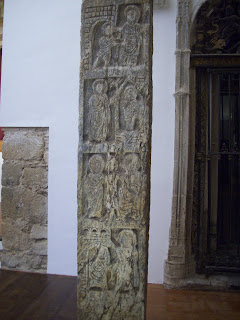
Códoba is a neat town. The heat is impressive, and the humidity is a bit higher than in Castilla. The town is not unlike Ravenna, in that both reminded me of Florida. Our hotel is fantastically close to the Mezquita.
This blog began as my travelogue for my research trip to Spain during the summer of 2009. My plan is to keep it alive as a general travel-oriented blog. Updates may be sporadic.

Andalucia is a distinctly different region of Spain than Castilla. The z and the c seem to retain their soft pronunciation here: gracias is pronounced “grasias”, not “grathias”. The agriculture has changed a little too. Castilla grows the Roman trifecta: grain, grapes, olives. Andalucia has a lot more olive orchards, as well as citrus. There are still grain and grapes, but in lower quantities. Sugar cane and sunflowers abound as well.

 ena, and is in very hilly countryside. The cow pastures surrounding the village are the only real plains (Navas) around. There are also the remains of a Muslim-built watch tower that the Christians renamed the Castillo de Las Navas de Tolosa.
ena, and is in very hilly countryside. The cow pastures surrounding the village are the only real plains (Navas) around. There are also the remains of a Muslim-built watch tower that the Christians renamed the Castillo de Las Navas de Tolosa.


I can’t get over the number of really poor translations from Spanish to English which we keep stumbling on. Valdepeñas offered some really nice examples. In the commercial district of this town’s very pleasant downtown, we discovered a clothing store called “New & Clothes”. I assume, given the fact that the Statue of Liberty graced their logo, they meant it to be a pun on NYC, with the Spanish word for ‘and’: New y Clothes.



The third castle we visited was the ruins of Alarcos. I am almost 100% certain that part of the movie Gladiator was filmed here.
Alarcos sits on a stout hilltop over the headwaters of the Gudiana River, several miles to the west of Calatrava la Vieja. The sight was originally occupied by Iberians, the pre-Roman, pre-Carthaginian people of Spain, as early as the sixth century BC. It remained occupied for several centuries, with at least two different phases of construction.
In the twelfth century, Alfonso VIII of Castile decided to fortify the site and construct a new city in the region. On the uppermost part of the hill, the foundations of a large castle were laid out, and the lower flanks of the hill were occupied with the structures of the new town. In conjunction with Calatrava la Vieja, the two forts would allow the Castilians to control the entire Campo de Calatrava, which at the time was the central frontier with Almohad-controlled Al-Andalus.
In 1195, the Almohad Caliph decided to challenge the Castilian defensive system, and sent an army against Alarcos. Alfonso VIII rushed his forces south from Toledo to defend the site, without waiting for promised reinforcements from his cousin, Alfonso XI of León. The Castilians were badly beaten on the plains south of the new castle. The King barely escaped, and his alferez (standard-bearer), Diego Lopez de Haro, defended Alarcos against the besieging Almohads for several days, until he negotiated a surrender which allowed him and his forces to retreat.
The defeat at Alarcos badly affected Alfonso VIII, and left Castile open to attacks from the Almohads. Calatrava la Vieja fell shortly thereafter, and soon the Muslim forces were harassing Toledo itself. Alfonso was forced to negotiate a ten year truce, which accepted the Muslim conquest of La Mancha.
In 1212, Alarcos was recaptured by the Castilians, though it was decided soon thereafter that it was not an ideal site for a new city. The colonial experiment was moved a few miles to the east, to the present Ciudad Real. Only a small hermitage remained at Alarcos.

 Today we traveled south from Toledo, tracing the path that the combined Christian armies followed on their way to meet the Almohads at the battle of Las Navas de Tolosa in 1212.
Today we traveled south from Toledo, tracing the path that the combined Christian armies followed on their way to meet the Almohads at the battle of Las Navas de Tolosa in 1212.












